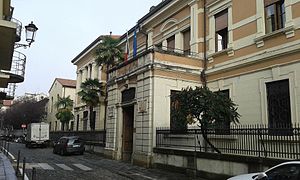Padua University Library
| Padua University Library | |
|---|---|
 Entrance to the university library
|
|
| founding | 1629 |
| Duration | about 780,000 media |
| Library type | University library |
| place |
Padua |
| ISIL | IT-PD0158 |
| operator | Ministry of Cultural Goods and Tourism |
| Website | Biblioteca Universitaria di Padova |
The University Library of Padua (Biblioteca universitaria di Padova) is the main library of the University of Padua . The library, founded in 1629, is the oldest university library in Italy. It has been in Via S. Biagio 7 since 1912.
History and holdings
The library received the basic stock of manuscripts and incunabula from the monasteries that were dissolved under Napoleon at the beginning of the 19th century . These are 2,745 manuscripts from the 11th to the 20th century, primarily historical and theological writings. There are also mathematical and medical, but also philosophical and legal work. One of the most important is Augustine's De civitate Dei . The house also has the only manuscript of the Itinerario , an autograph by Marin Sanudo , in which he made his 1483 tour through the mainland areas of the Republic of Venice together with the Sindaci di terrafermadescribes. The manuscript comes from the Benedictine monastery on the Venetian island of San Giorgio maggiore . The work contains numerous sketches of cities and fortresses. In addition, the house contains musical historical gems from the 14th and 15th centuries from the Benedictine monastery of Santa Giustina, as well as sketches of ships from the 18th century, which are of great importance for the reconstruction of the late maritime history of the republic. More recent manuscripts, such as that of the positivist and professor at the University of Padua Roberto Ardigò , also represent an important collection.
The incunabula, i.e. printed works from the period before 1500, are 1132 editions in a total of 1583 incunabula. These include the novella Ippolito e Leonora from 1471, which was assigned to Lorenzo Canozi da Lendinara , the first printer in Padua , on the basis of a handwritten entry . De re militari , Verona 1472, with miniatures and calligraphies by Felice Feliciano is considered a further gem .
A total of 9622 cinquecentines , i.e. prints from the 16th century, and more than 100,000 editions from the 17th and 18th centuries are counted . Armenian prints from the Venetian island of San Lazzaro degli Armeni , as well as the Hebrew texts from the Morpurgo collection, represent a particularly noteworthy fund .
Numerous periodicals of the Ancien Régime , such as the complete editions of the Journal des savants or the Philosophical Transactions of the Royal Society , were the starting point for further magazine collections. In total, it concerns issues of 6765 periodicals, of which 487 are current (as of 2018).
Web links
Remarks
- ^ History of the Padua University Library (Italian) accessed on October 16, 2018
- ↑ Itinerario per la terraferma veneziana , Ms.996.